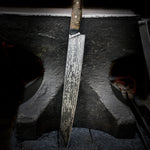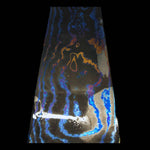5lb Box of Damascus End Cuts
5 LB Box of Damascus Steel End Cuts – Unique Damascus Assortment for Makers
Every box of Damascus steel end cuts is a treasure chest for makers. Packed with 5 pounds of assorted remnants, each box contains a mix of patterns, alloys, shapes, and sizes — no two boxes are ever the same. Perfect for knifemakers, jewelers, blacksmiths, and hobbyists who want to experiment with Damascus without committing to full billets.
📦 What’s Included:
-
5 lbs of Damascus end cut pieces (varied patterns & alloys)
-
Pre-packed in a USPS Small Flat Rate box (8.6875″ × 5.4375″ × 1.75″)
-
Small vial of bluing solution for quick alloy testing
🔧 Ways to Use Your Box:
-
Forging small parts and fittings
-
Jewelry making and decorative projects
-
Practicing etching and exploring Damascus patterns
-
Experimental “tinkering” projects for hobbyists
⚠️ Please Note:
-
End cuts are not labeled by alloy or pattern.
-
Use the included bluing fluid to test:
-
Carbon Damascus → darkens when applied
-
Stainless Damascus → no reaction
-
-
If you require a specific alloy or pattern, we recommend ordering our billets or rods for guaranteed selection.
✨ Whether you’re sharpening your skills, testing new ideas, or simply want a variety of Damascus pieces to play with, this 5 lb box delivers endless creative possibilities.
How to Etch Stainless & Carbon Damascus

How to Heat Treat Carbon (0-1) Damascus

How to Color Damtanium and Zirmascus

How to Heat Treat Carbon (1095) Damascus
| Tempering: Typical harnesses of 1095 carbon steel after tempering for 2 hours at different temperatures | ||
| Grade | Temperature, °C (°F) | Rockwell hardness, HRC |
| 1095 high carbon steel, carbon content: 0.95% | 205°C (400°F) | 58 HRC |
| 260°C (500°F) | 57 HRC | |
| 315°C (600°F) | 52 HRC | |
| 370°C (700°F) | 47 HRC | |
| 425°C (800°F) | 43 HRC | |
| 480°C (900°F) | 42 HRC | |
| 540°C (1000°F) | 41 HRC | |
| 595°C (1100°F) | 40 HRC | |
| 650°C (1200°F) | 33 HRC | |
How to Heat Treat Stainless (Aeb-L & 440C) Damascus

How to Heat Treat Carbon (1075) Damascus
| Temperature | Hardness (2hour x2 guidline) |
| 300°F / 149°C | 65 |
| 350°F / 177°C | 63-64 |
| 400°F / 204°C | 60-61 |
| 450°F / 232°C | 57-58 |
| 500°F / 260°C | 55-56 |
| 550°F / 288°C | 53-54 |
| 600°F / 316°C | 52-53 |
